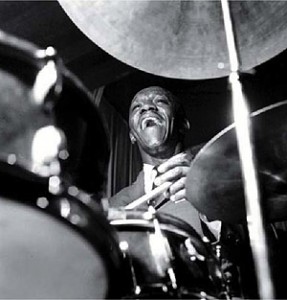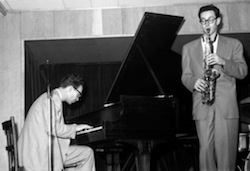‘Time Out’ was one of the first jazz discs I ever heard (my dad had it on record). I also remember learning ‘Take Five’ by ear in the living room of my house as a teenager one afternoon when no one was home. I had been playing alto sax for a little more then a year after 4 years of clarinet. I love the clarinet now and wish I had kept playing it more, but at the time I felt like I was moving up to a cool wind instrument! I was a teenage boy and I just didn’t see the girls going for a myopic clarinetist with a bad hair. A myopic saxophonist with bad hair though had a chance. Anyways, my first memories of hearing ‘Time Out’ come closely on the heals of hearing ‘Blue Train’ and ‘Kind of Blue’, and I had no problem telling people at this point that I liked jazz. And I REALLY did get into jazz at this point. One thing that surprises me a little now though is how well ‘Kind Of Blue’ and ‘Blue Train’ still stand up for me.
While there are some great tracks on ‘Time Out’, the album seems much blander and run of the mill to me now. I heard ‘Blue Rondo A La Turk’ streaming out of a car the other night at the Tacoma Dome while waiting for the girls to pick me up. KPLU plays a lot of Brubeck. In fact, a couple years ago they did a ‘greatest 100 jazz albums of all time’ countdown, and I heard probably the top 10… when they got to number 2 and started to play ‘All Blues’, I was seriously stumped about what could possibly be number 1. Then they introduced ‘Time Out’ and played ‘Take Five’. Now, it is a good song and a good album… but better then Miles Davis with John Coltrane? This moment summed up for me how serious KPLU was about its jazz programming… if ‘Time Out’ is the greatest jazz album of all time in their eyes then … well, there just isn’t a polite way of saying how off these guys are. And for the most part listening to KPLU is like listening to the clean, sanitized version of jazz. It isn’t playing the smooth jazz that KKSF in San Francisco is known for, but it certainly isn’t playing the out there late Coltrane stuff either. It’s nice, safe middle ground jazz for public radio listeners.
I was actually talking to a friend a few months ago about why ‘Blue Train’ and ‘Kind of Blue’ still work for me, but ‘Time Out’ doesn’t. And I think it goes back to that afternoon I spent figuring out ‘Take Five’… I was able to figure it out. The whole album, as it explores different meters, is actually quite rigid. There are times when it swings, but even then it is a VERY controlled and precise swing. I was able to get it down. But the nuance, phrasing and feeling on the Coltrane record and on ‘Kind of Blue’ is all very subtle with slight give and take all over the place. I could spend some time writing all the notes down to learn them, and I am sure I still couldn’t capture what is happening on those discs (especially since, if I could play EXACTLY what is on those recordings I would be missing out on a huge part of what that musical tradition is!). And I think that is one of the reasons they still keep my attention so strongly. They ARE jazz classics, quite popular and accessible. But there is SO much more once you get beyond that level. Unfortunately, I’m not sure how deep I feel the Brubeck disc is. Some nice songs, and I think the group plays amazingly well together. But I don’t feel an excitement over it any more.
The Art Blakey discs however are just damn amazing. While I wouldn’t expect to hear either of these in a Top 10 (the discs tonight were ‘A Night In Tunisia’ from the Rudy Van Gelder Series and a Jazz Messengers disc with Thelonious Monk) they feature some exhilarating performances. The Monk disc is just lots of fun. Blakey and Monk are basically passing on tradition to some younger sidemen… something that Art Blakey in particular would spend so much of his career doing.
The ‘A Night In Tunisia’ disc features Lee Morgan and a young Wayne Shorter. I once heard a story about Dizzy Gillespie where he was trying to explain how him and Charlie Parker thought about bop music. He said that they just wanted to play faster then any one else could so they couldn’t be imitated. This Art Blakey version, I imagine, would have made Dizzy’s jaw drop. When I got the disc I noticed the title track was over 11 minutes long, and I assumed it was a more relaxed version of the tune. It turned out that it is really a 20 minute version that is played at double speed. It is a roller coaster of a recording and the playing is almost unbelievable. Except there it is… in 1960 you couldn’t fake this kind of playing.



